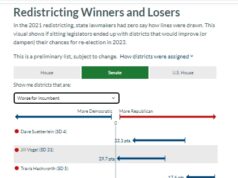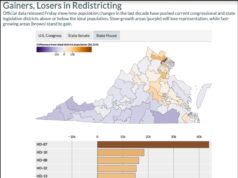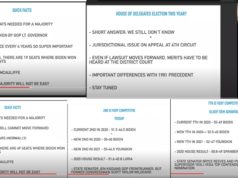Wow, strong words from Bob Holsworth (see below; bolding added by me for emphasis; also, h/t to Brandon Jarvis of Virginia Scope for first tweeting about this), who “served in 2011 as Chair of Governor Bob McDonnell’s Independent Advisory Commission on Redistricting.” I mostly agree with what Holsworth says here, although I do *strongly* disagree that this was the fault of the Democratic Party of Virginia; in fact, it was the fault of Republicans who pushed the fatally flawed redistricting amendment, plus the vast majority of Democratic State Senators (with a couple exceptions, Sen. Scott Surovell and Sen. John Edwards) and handful of Democratic Delegates who failed to stop it when they had a chance, plus outside groups which poured money into misleading voters…
The Redistricting Contraption
I served in 2011 as Chair of Governor Bob McDonnell’s Independent Advisory Commission on Redistricting. The Commission had 6 self-identified Democrats, 6 self-identified Republicans and I was the independent chair.
The Commission produced a set of “model maps” that demonstrated it was possible to design Assembly and Congressional districts that were more compact and more respectful of communities of interest while still being consistent with the principles of the Voting Rights Act that existed in 2011.
Our work was widely applauded by editorial pages across the Commonwealth. And it was summarily ignored by the Republican leaders in the House and the Democratic leaders in the Senate who went about redistricting as usual.
The Commission, aided by a student map drawing contest in Virginia universities and law schools and by faculty experts, did excellent work. But there an important feature of our efforts that went largely unnoticed. The Commission members could not agree on a SINGLE map for both the Assembly and Congressional districts. Even on an advisory commission with no actual power and no legislative members, reaching agreement on one redistricting map was extraordinarily challenging.
As I watched the Assembly create the redistricting Commission that is actually charged with drawing the maps today, it was clear that the issue that confronted our advisory Commission was only being exacerbated.
Giving 8 of the 16 slots on the Commission to legislators removed its “independence.” Requiring supermajority votes from both legislative and citizen members, intended to promote consensus, makes deadlock an equally likely outcome. And the decision to punt redistricting over to the Virginia Supreme Court if an agreement cannot be reached is a disincentive for consensus if one side believes that it might do better in the courts than on the Commission.
Initial reports on the Commission’s deliberations have not allayed these concerns. Citizen commissioners have expressed concern about the outsized influence of legislative members and yesterday the Commission decided to hire two partisan firms, one Democratic and one Republican, to produce their first set of maps.
It still may be possible to reach agreement on a map that is more compact, respects community interests, and doesn’t split as many precincts. (Republicans may worry that the demographic shift toward NOVA could truly disadvantage them in a court drawn process.) But really, given the composition of the Commission, the most likely agreement is one where incumbent protection is a primary driver- not an outcome that the public thought it was endorsing.
Two final thoughts.
First, it will not be easy to address the problems that have arisen in the design of the Commission and tweak the process based on this years experience insofar as last year’s referendum has now enshrined the contraption in the Virginia Constitution.
Second, as the national redistricting process begins that could have a decisive outcome on the composition of state legislatures and Congress in 2022 and beyond, the Virginia Democratic Party may be the only state party in the country in this cycle that has willingly conceded the total control it held over redistricting.
Having endorsed non-partisan redistricting when the party was in the minority, many Democrats felt that going forward with the Commission was preferable to being labeled total hypocrites. It does, however, raise a question.
Are Virginia Democrats the most altruistic, public spirited state party in the country?
Or the most naive?


 Sign up for the Blue Virginia breaking news newsletter
Sign up for the Blue Virginia breaking news newsletter








![“Attorney General [Jason Miyares] is a coward who refuses to defend our state’s laws [against so-called ‘conversion therapy’] that demonstrably prevent suicide”; “Glenn Youngkin is simply despicable”](https://bluevirginia.us/wp-content/uploads/2025/07/youngkindespicable-100x75.jpg)